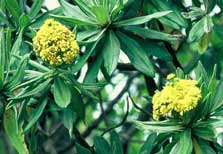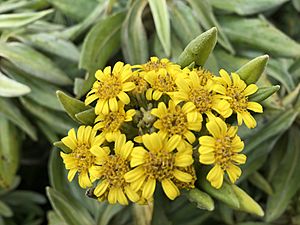Rautini facts for kids
Quick facts for kids Rautini |
|
|---|---|
 |
|
| Conservation status | |
 Nationally Vulnerable (NZ TCS) |
|
| Scientific classification | |
| Genus: |
Brachyglottis
|
| Species: |
huntii
|
| Synonyms | |
|
Senecio huntii F. Muell. |
|
Brachyglottis huntii, often called Rautini or the Chatham Island Christmas tree, is a special flowering plant. It is part of the daisy family, known as Asteraceae. You can only find this unique plant on the Chatham Islands in New Zealand.
Contents
What Does Rautini Look Like?
The Rautini plant can grow quite tall, up to 8 meters (about 26 feet) high. Its leaves can be as long as 12 centimeters (about 5 inches). The whole plant is covered in soft, fuzzy hairs, which make it look silvery.
In the summer, from November to February, Rautini produces bright yellow flowers. After the flowers, it makes seeds during the autumn season. The tree has grey bark that peels off in small pieces. Its leaves have tiny teeth along the top edge and smell nice. When they are young, the leaves are covered in short, matted hairs, but they become smoother as they get older. The branches are short and strong, spreading out from the trunk.
Rautini contains certain natural chemicals. These chemicals are not safe to eat and can be harmful if consumed.
Where Does Rautini Live?
In the last 100 years, the number of Rautini plants on Chatham Island has gone down. This is because animals eat them and their homes (habitats) are being destroyed. However, on Pitt Island, there are more Rautini plants because fewer farm animals or wild animals graze there.
Rautini likes to grow in places that have been disturbed, or in areas where new plants are just starting to grow. These places include along streams and rivers, in drier swampy areas, open shrublands, and along open ridges. This plant does not do well if there is a long time without rain, or if it grows in very shady spots.
What Threats Does Rautini Face?
Young Rautini plants are tasty to farm animals. These animals can cause a lot of damage by eating the plants or by stepping on them. Losing their natural homes is also a big problem for these plants.
Recently, some healthy Rautini trees have suddenly fallen over. Scientists think that plant diseases in the soil might be causing this. More research is needed to understand why this is happening.
See also
 In Spanish: Brachyglottis huntii para niños
In Spanish: Brachyglottis huntii para niños


